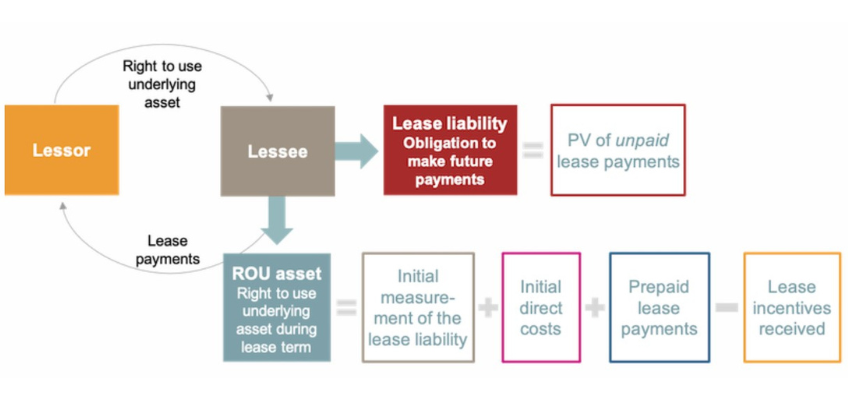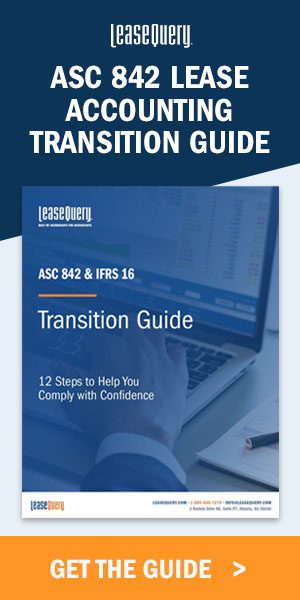This article, "Accounting for Leases under IFRS 16: An Overview," originally appeared on GAAPDynamics.com.
Summary provided by MaterialAccounting.com: This article provides an overview of the lease accounting standard, IFRS 16.
Lease accounting…a broad accounting topic that transcends industries and, under IFRS 16, makes its way to most balance sheets. It’s hard to find a company out there without at least one lease. The guidance in IFRS 16 is fairly new (well, new as far as accounting standards go), and significantly changed the previous guidance for lease accounting. It covers the recognition, measurement, presentation, and disclosure requirements for leases, and was effective for annual reporting periods beginning on or after January 1, 2019. This post will provide an overview of IFRS 16 and discuss what training is available to continue your quest for knowledge about lease accounting under IFRS!
Overview of IFRS 16
IFRS 16 applies to all leases, including subleases, with only a few exceptions. It provides guidance for both lessees and lessors. However, before applying lease accounting, entities first need to determine whether a contract is a lease or contains a lease. This can be challenging as not all contracts that meet the definition of a lease are clearly labeled as such. IFRS 16 states that “a contract is, or contains, a lease if the contract conveys the right to control the use of an identified asset for a period of time in exchange for consideration. It also provides guidance on applying this definition. In addition, a contract may contain a lease component and non-lease component(s). The non-lease components should be separated and accounted for under their applicable standard (e.g., IFRS 15, Revenue from Contracts with Customers) unless a practical expedient applies and is elected.
Next up, before we can apply debits and credits to account for the lease, is to determine the lease term, lease payments, and the discount rate. These key concepts are applicable to both lessees and lessors.
The lease term represents the period of use for the asset, which is the period over which the lease payments will be recognized. Therefore, determining the right lease term will have a direct impact on the recorded lease assets and liabilities. The lease term is not just the noncancelable term. Other factors must be evaluated such as optional renewal periods, periods after an optional termination date, and lessor options to extend a lease. There is often judgment involved when determining the lease term.
Lease payments are the payments made by the lessee to the lessor for the right to use the underlying asset during the lease term and include the following:

Determining what is included in the lease payments is essential to the measurement of the lease liability and the right of use asset.
Finally, the discount rate is important to the accounting for leases because it is used to calculate the present value of the lease payments. A lessee should use the interest rate implicit in the lease if it can be readily determined. If not, then the incremental borrowing rate should be used. Again, IFRS 16 provides guidance on determining the discount rate, particularly determining the incremental borrowing rate, which involves judgment.
Overview of lessee accounting
Under IFRS 16, all leases will be recorded on the balance sheet, with the exception of short-term leases if the lessee elects the recognition and measurement exemption for those short-term leases. Therefore, at the commencement date of a lease, the lessee calculates and records a lease liability and a right of use asset, as illustrated by the following diagram:

Subsequent accounting for the lease liability by a lessee involves:
- Increasing the carrying amount of the lease liability to reflect interest on the lease liability (Interest should be the amount that produces a constant periodic rate of interest on the remaining balance of the lease liability),
- Reducing the carrying amount of the lease liability to reflect the lease payments made,
- Remeasuring the carrying amount of the lease liability to reflect any lease reassessments, lease modifications, or to reflect revised in-substance fixed lease payments
A lessee should recognize, generally in profit or loss, both interest on the lease liability and any variable lease payments incurred that were not included in the measurement of the lease liability.
IFRS requires the lessee to subsequently measure the right-of-use asset by applying a cost model unless it applies the fair value model (IAS 40) or the revaluation model (IAS 16). Under the cost model, a lessee should measure the right-of-use asset at cost:
- Less any accumulated depreciation and any accumulated impairment losses; and
- Adjusted for any remeasurement of the lease liability
The right-of-use asset is subject to impairment considerations and the lessee should apply IAS 36 when determining if the right-of-use asset is impaired.
Other guidance
IFRS 16 includes guidance on numerous additional topics not covered by this post, including:
To learn more about the topics covered in this post as well as some of the ones listed above that were not covered, check out our eLearning series below!
Leases: Overview of IFRS 16
In this CPE-eligible (1.5 CPE) eLearning course you will learn not only how to identify leases within the scope of IFRS 16, but also how to record them on the balance sheet by determining the lease term, lease payments, and discount rate. The course concludes with an overview of the accounting for leases by both lessees and lessors.
By the end of this course, you should be able to:
- Recognize whether a contract, or a part of a contract, contains a lease and is within the scope of IFRS 16
- Recall the key concepts and inputs related to accounting for leases under IFRS 16
- Identify the proper accounting for leases by both lessees and lessors
Leases: Lessee Accounting and Application Issues
In this CPE-eligible (1.0 CPE) eLearning course you will learn about the initial recognition, initial measurement, and subsequent measurement of leases from the lessee’s perspective. The course also discusses how to account for changes to the lease arrangement after the commencement date.
By the end of this course, you should be able to:
- Recall the initial recognition and measurement of leases under IFRS 16 for a lessee
- Recall the subsequent measurement of leases under IFRS 16 for a lessee
About GAAP Dynamics
We’re a DIFFERENT type of accounting training firm. We don’t think of training as a “tick the box” exercise, but rather an opportunity to empower your people to help them make the right decisions at the right time. Whether it’s U.S. GAAP training, IFRS training, or audit training, we’ve helped thousands of professionals since 2001. Our clients include some of the largest accounting firms and companies in the world. As lifelong learners, we believe training is important. As CPAs, we believe great training is vital to doing your job well and maintaining the public trust. We want to help you understand complex accounting matters and we believe you deserve the best training in the world, regardless of whether you work for a large, multinational company or a small, regional accounting firm. We passionately create high-quality training that we would want to take. This means it is accurate, relevant, engaging, visually appealing, and fun. That’s our brand promise. Want to learn more about how GAAP Dynamics can help you? Let’s talk!
Disclaimer
This post is published to spread the love of GAAP and provided for informational purposes only. Although we are CPAs and have made every effort to ensure the factual accuracy of the post as of the date it was published, we are not responsible for your ultimate compliance with accounting or auditing standards and you agree not to hold us responsible for such. In addition, we take no responsibility for updating old posts, but may do so from time to time.


